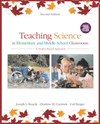 |  Teaching Children Science: A Project-Based Approach, 2/e Joe Krajcik,
University of Michigan - Ann Arbor
Charlene Czerniak,
University of Toledo
Carl Berger,
University of Michigan - Ann Arbor
How Do I Manage the Project-Based Science Classroom?
Chapter Summary- Many unwelcome classroom behaviors can often be traced to the larger classroom context and the curriculum.
- A constructivist classroom environment asks students to reflect on what they should do and to solve problems together.
- In a positive classroom climate
- Students have real choices.
- Teachers are role models for good behavior and science inquiry.
- Instructional planning focuses on good curriculum.
- Teachers exude a positive attitude toward science.
- Teachers promote positive affective factors such as curiosity, excitement, persistence, enthusiasm, skepticism, and open-mindedness.
- Maintaining a balanced teacher-student relationship helps create a classroom learning community where students feel safe.
- Teachers ensure equality by focusing on classroom practices that help all students learn.
- A well-planned classroom arrangement supports project-based science through
- Creating an effective physical arrangement.
- Keeping high traffic areas free of congestion.
- Ensuring that students can be seen by the teacher.
- Keeping frequently used materials and supplies readily accessible.
- Being certain students can see displays as well as see and hear presentations.
- The structure of the school day influences classroom management through
- The number of minutes allocated to a subject area,
- The delivery of science as a subject area, and
- The daily schedule of activities or lessons.
- A safe classroom helps ensure that all students learn.
- In a safe classroom,
- Animals and plants are healthy and well cared for and do not harm students.
- Goggles are used in science classrooms.
- Shelving, supplies, and materials are safely stored.
- Students learn the safe use of electricity.
- Sources of fire are eliminated or controlled.
- Glassware is replaced with plastic or its use is carefully monitored.
- Field trips are well planned to ensure safety and learning by all students.
- Teachers are familiar with first aid procedures.
- Management strategies are used to help develop welcoming classroom learning communities where students can learn effectively.
- Teachers need to focus on classroom management before instruction, during instruction, and after instruction.
- To create a positive classroom before instruction,
- Establish norms for acceptable student behavior.
- Establish an atmosphere that fosters "good" behavior.
- Reward students by focusing on effort.
- Use caution when using "rewards" because they are viewed by some to be coercive.
- Set up contracts with students to promote self-responsibility.
- Effective classroom teachers anticipate problems before they occur and plan accordingly.
- Several factors to consider during instruction are:
- The distribution of materials and supplies.
- Making transitions.
- Dealing with disturbances.
- Handling multiple instances of the same activities.
- Handling multiple instances of different activities at the same time.
- Teachers need to continually reinforce classroom norms, revisit classroom norms, and evaluate progress before, throughout, and after the project.
- After instruction, students and teachers should reflect on classroom norms, on the effectiveness of instruction, and on student behavior.
- Teachers can collaborate with their peers to develop good classroom management strategies.
|
|



 2003 McGraw-Hill Higher Education
2003 McGraw-Hill Higher Education